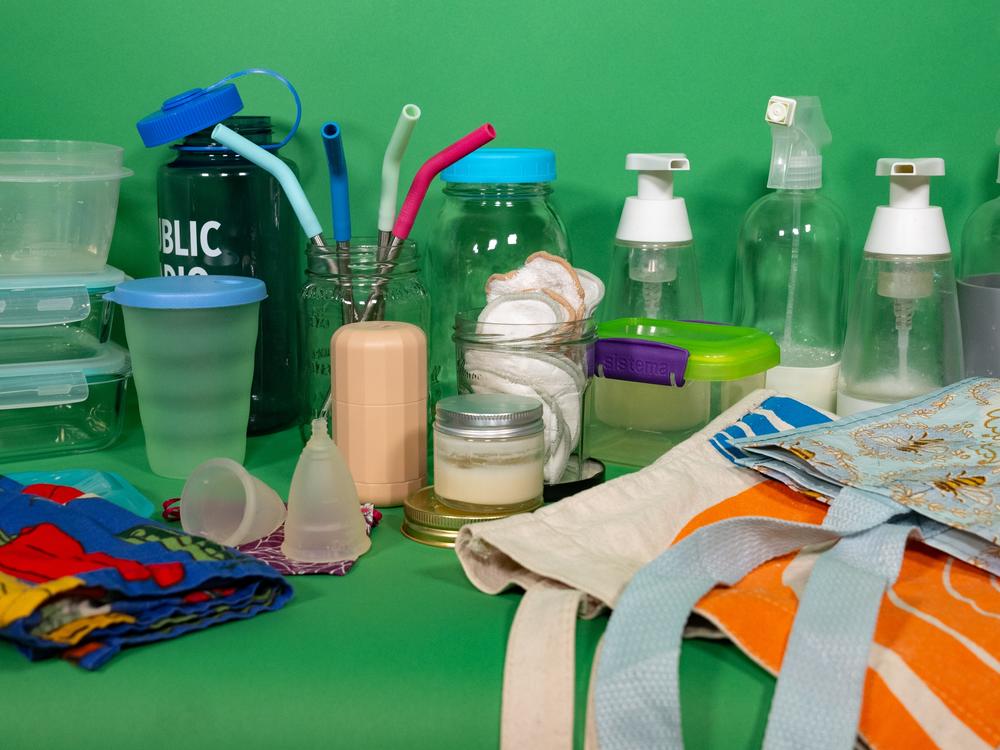Section Branding
Header Content
How to live without plastics for a month, according to the founder of a global movement
Primary Content
What would a month without buying any new single-use plastic products look like?
It’s a tall order for many Americans, who go through about five pounds of plastic a week, according to Oxford University’s Our World In Data. Most of that plastic will end up in a landfill and take anywhere from 20 years to centuries to decompose.
This level of plastic waste inspired the Plastic Free July movement, which aims to engage individuals to reduce single-use plastic consumption as well as push for systemic change.
Rebecca Prince-Ruiz founded the movement in 2011 after touring a local recycling facility in Western Australia. Seeing the mountain of plastic her town generated made her understand the need to create less of it in the first place. The following month, she and her coworkers cut single-use plastics from their lives. Millions have undertaken the same challenge in the years since.
Going plastic-free made Prince-Ruiz build new habits in little ways she hadn’t anticipated. Sitting down to drink coffee at a cafe rather than downing it from a plastic cup while commuting made her more mindful. Making garlic bread from scratch instead of buying a frozen bag became a way to spend time with her son.
“I think plastic, in some ways, is a symbol of how busy we've become; of the throwaway society that we've become,” Prince-Ruiz said.
So how can someone prepare for a plastic-free July?
Prince-Ruiz recommends carrying a “plastic-free kit” with you in your work bag, gym bag, car or bike for leftovers or fast food.
For people doing Plastic Free July for the first time, Prince-Ruiz recommends not trying to change everything all at once.
“Use what you have, do what you can, don't focus on what you can't,” she said.
The changes that stick are the ones that work well with your current lifestyle, which is why doing too much too fast can lead to burnout.
Prince-Ruiz also recommends doing the challenge with friends.
She says that a good place to start is looking in your trash can, refrigerator and pantry to review the types of waste you’re creating — and looking for alternatives from there.
Trying to cut plastic use isn’t easy or an option for everyone, Prince-Ruiz warns. It can require more planning, more time and in many cases, more money.
Still, individual actions can have an impact: Last year, she estimates 89 million people worldwide participated in Plastic Free July (though some may have signed up for just a week or a day), reducing over 500 million pounds of household single-use plastics.
Over the past decade, Prince-Ruiz has seen an increased appetite to reduce plastic.
“There's so many community groups and NGOs working on this issue that this groundswell of community change has started to put pressure on business and government, and we're starting to see systemic change,” Prince-Ruiz said. “So I think we've come a long way. We still have so far to go.”
Prince-Ruiz and people around the world trying for a plastic-free July will have some company
I’ll be joining them starting tomorrow, for a week. Here’s my game plan:
♻️ Cut out online shopping and food delivery;
♻️ Fill my own containers in the bulk section of my grocery store;
♻️ Carry a kit in my tote bag whenever I leave the house;
♻️ And replace single-use plastics with plastic-free alternatives if any run out.
If it’s impossible to buy a plastic-free alternative for an item such as string cheese, granola bars or potato chips, I’ll attempt to make it myself. Plus, having snacks on hand will hopefully help me avoid food delivery and fast food — as well as all of the plastic they bring.
Going plastic free could be easier for me than it would be for many Americans. I live in Washington, D.C., within walking distance of a grocery store that sells food in bulk — which isn’t the norm across the country.
At the end of this experiment, I’ll bring all of my plastic waste into the studio and report back on the costs, challenges and benefits. I’ll be back on Morning Edition on July 26 to talk about my plastic-free week.
Editor's note: This story has been updated to clarify that some participate in Plastic Free July for varying lengths of time. It has also been updated to reflect how long Morning Edition producer Claire Murashima will participate.
This story was edited for broadcast by Ally Schweitzer and edited for digital by Obed Manuel.


